Out-Of-Doors
Header Image: Carolina Wren
Once again, that mee-tee-oh-rah-low-gist was absolutely correct. Partly cloudy with temperatures about the same as yesterday. I missed my calling.
We pulled into the management area just before the sun was scheduled to make an appearance. Thin fog suggested the actual appearance would be somewhat later than Sol had in the day-planner. Atop the welcome sign, a Red-shouldered Hawk scanned the dew-soaked grass for any sign of movement, AKA: breakfast.
The fog was of such consistency that we could not see too far in any direction but Gini’s well-developed sense of hearing reported chips and tweets in abundance. Sandhill Cranes trumpeted overhead as they moved from their nightly roost to a nearby field where they would forage all day. The “churrrrr” of a Red-bellied Woodpecker advertised his location. Lakes were beginning to become noisy with the gabble of Common Gallinules and the eerie cry of a Limpkin split the early morning calm like that alarm clock did a short while ago.
There are locations throughout Tenoroc Fish Management Area that, over time, have proven to be consistently productive for observing bird life. Like a pair of surgeons in a convalescent ward, Gini and I make our rounds, checking the health of our patients and listening calmly as the wrens complain incessantly about their neighbors and the food. Doctor Gini announced it was already time for breakfast.
The fog didn’t last long and the clear blue sky and relatively mild temperature induced heavy sighs from us both. This. This is what life is about. Sharing nature’s beauty with someone you love. We had innumerable tasks which needed attention at the house. Some, admittedly, have needed attention for, well, a very long time. Our priorities are skewed. We know it. We accept it. Cleaning closets or holding hands while watching a Belted Kingfisher yell at the water? No contest.
I frequently feel I should apologize for subjecting you to too many images. Let us know if this is a recurring problem. There is no guarantee the issue will change, but at least I will be aware of your discomfort.
A pair of Red-shouldered Hawks begin the daily routine of hunting for food. One of our most common raptors, I feel it is one of the most handsome.
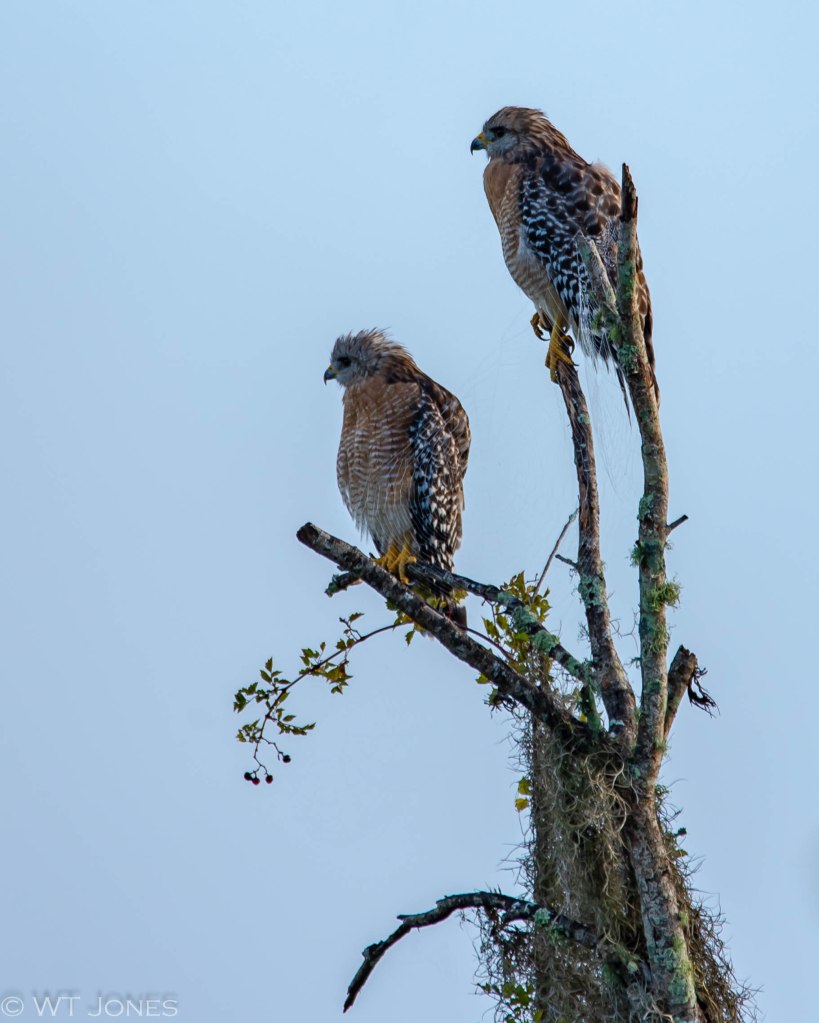
The beginning of fall migration season is often signaled by small songbirds gathering in large groups which can offer protection from predators as they journey southward. Blue-gray Gnatcatchers are one such species. We saw nearly three dozen during our morning outing.
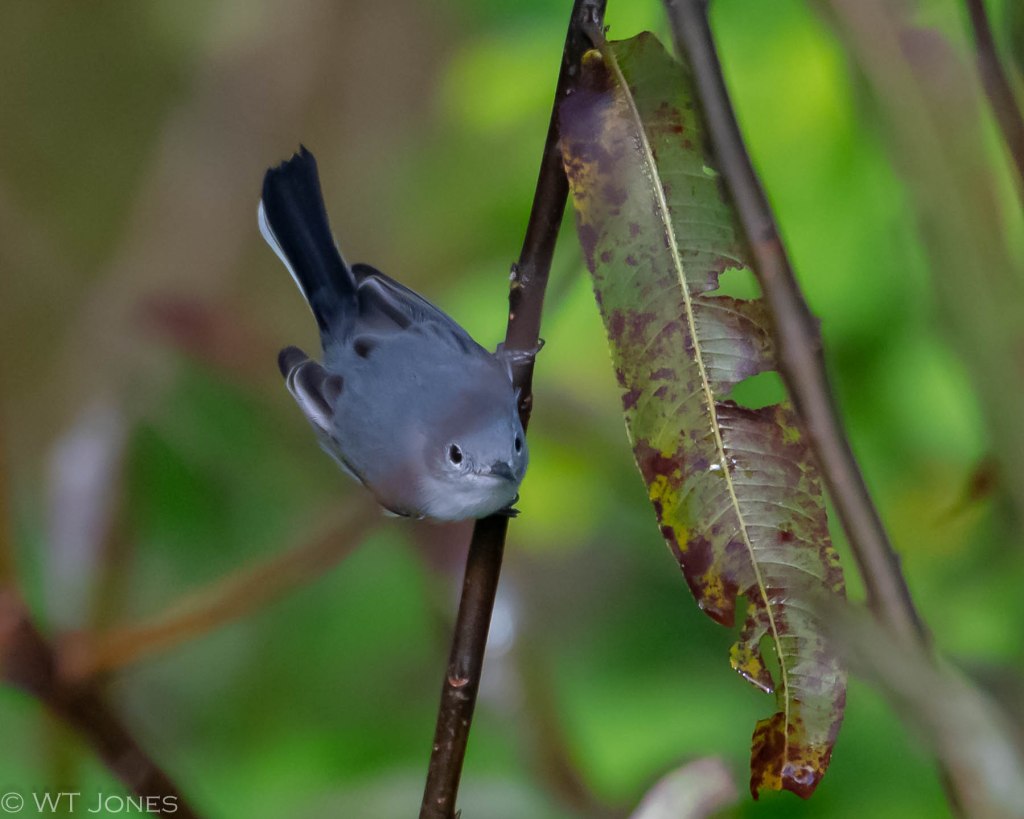
Wrens seem to be among the more aggressive members of the bird world. If they were as large as an eagle, they would be fearsome, indeed! A Carolina Wren confronted us as soon as we approached a hedgerow, demanding to know our intention. “Click.” Intention fulfilled. Thank you.
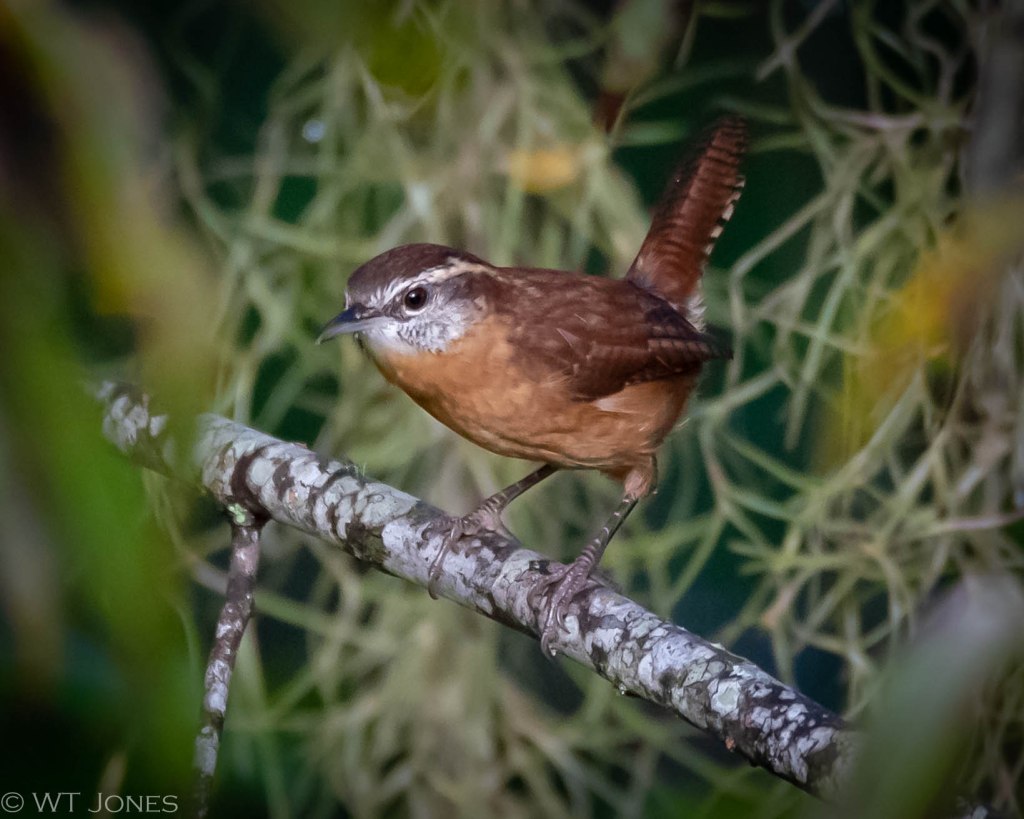
Curious as to why the Carolina Wren was yelling so loudly, a migratory Ovenbird skulked in the low branches, orange crest flared as she knew something had upset the wren so perhaps she should be upset, too. Some are not aware the Ovenbird is a warbler as it has thrush-like streaking on its undersides.
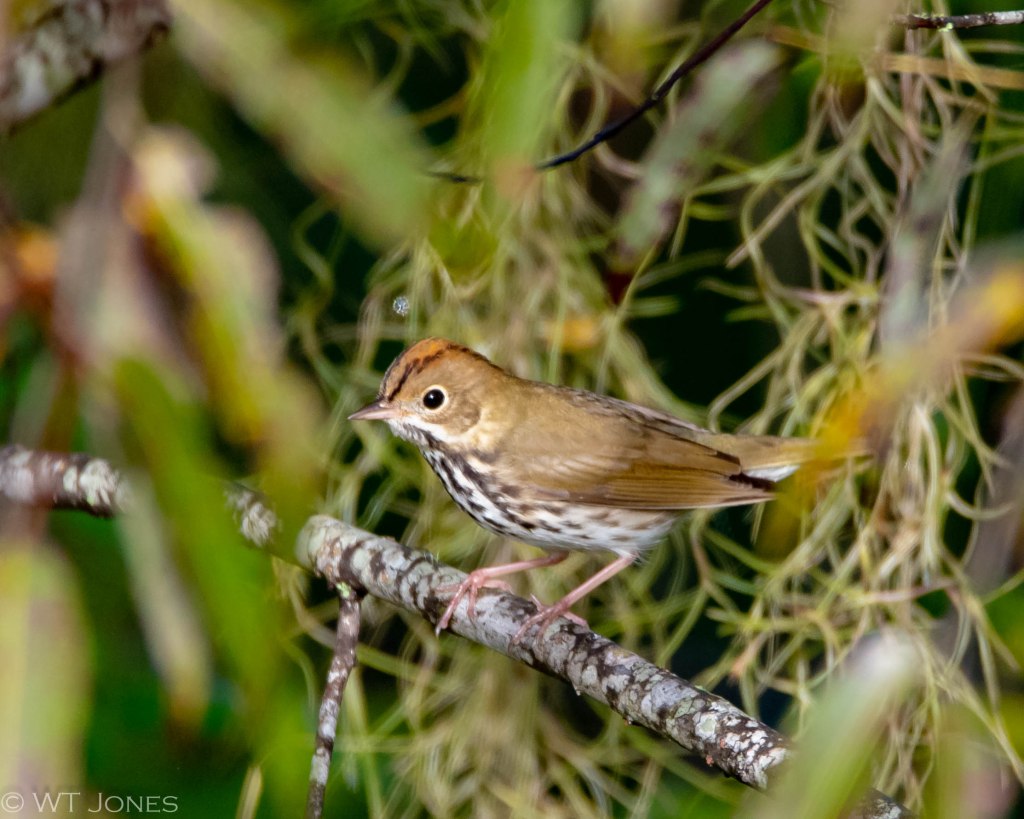
Insects abound in the area since we are seldom very far from water. This lovely specimen is the Flesh Fly (Sarcophagidae spp.). As one might expect from the Latin as well as its common name, its specialty is consuming decaying flesh.
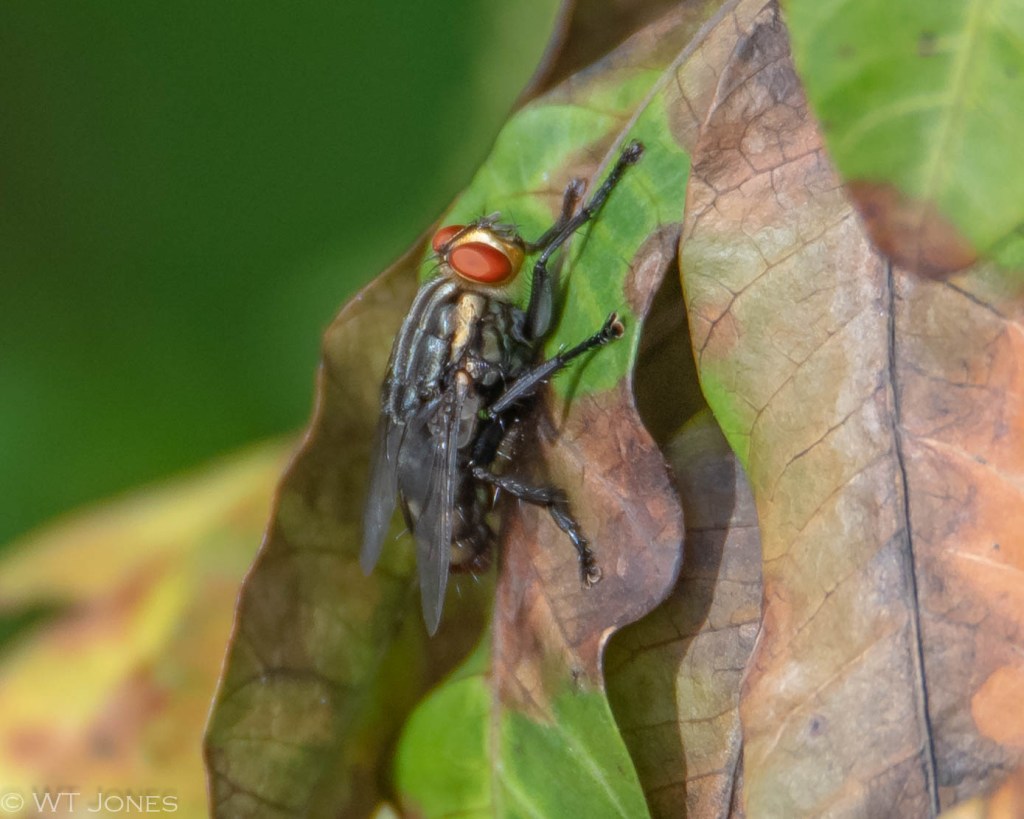
We’re lucky to have the Northern Parula here during breeding season and enjoy its ascending buzzy trill. In the fall, numbers of this warbler join with Titmice and Gnatcatchers in their trek southward.
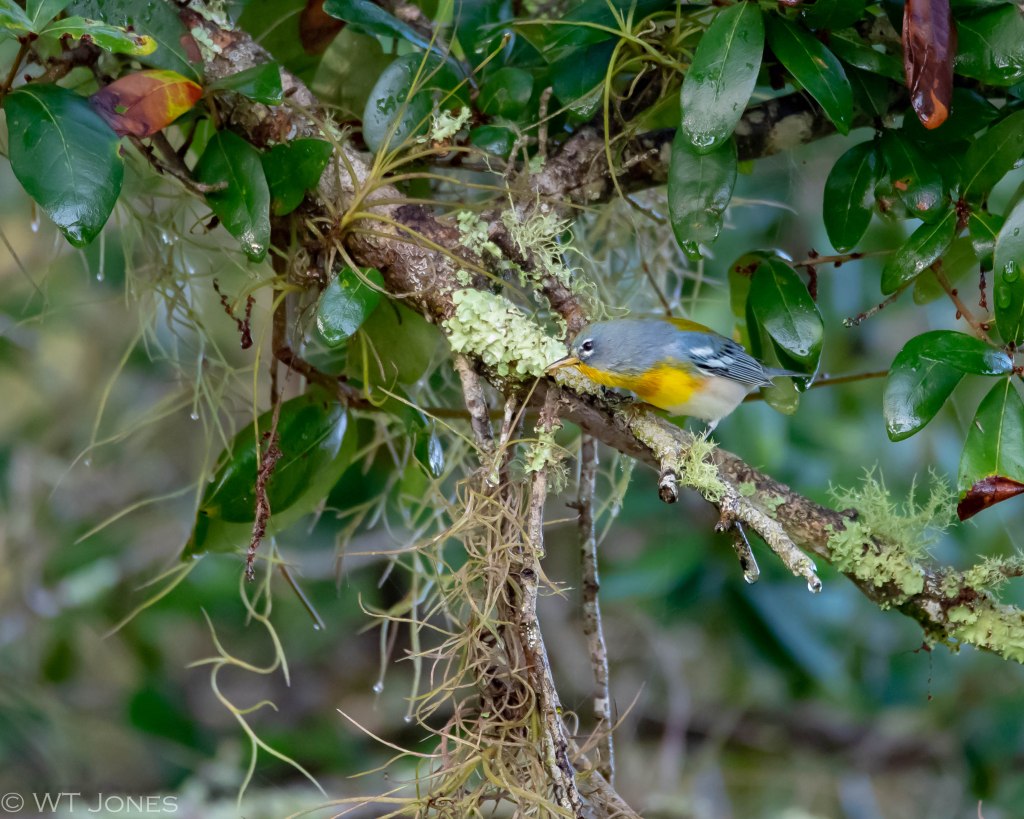
A demure female Common Yellowthroat looks like royalty surrounded by a field of dewy jewels. The male is more boldly colored and sports a black mask once mature.
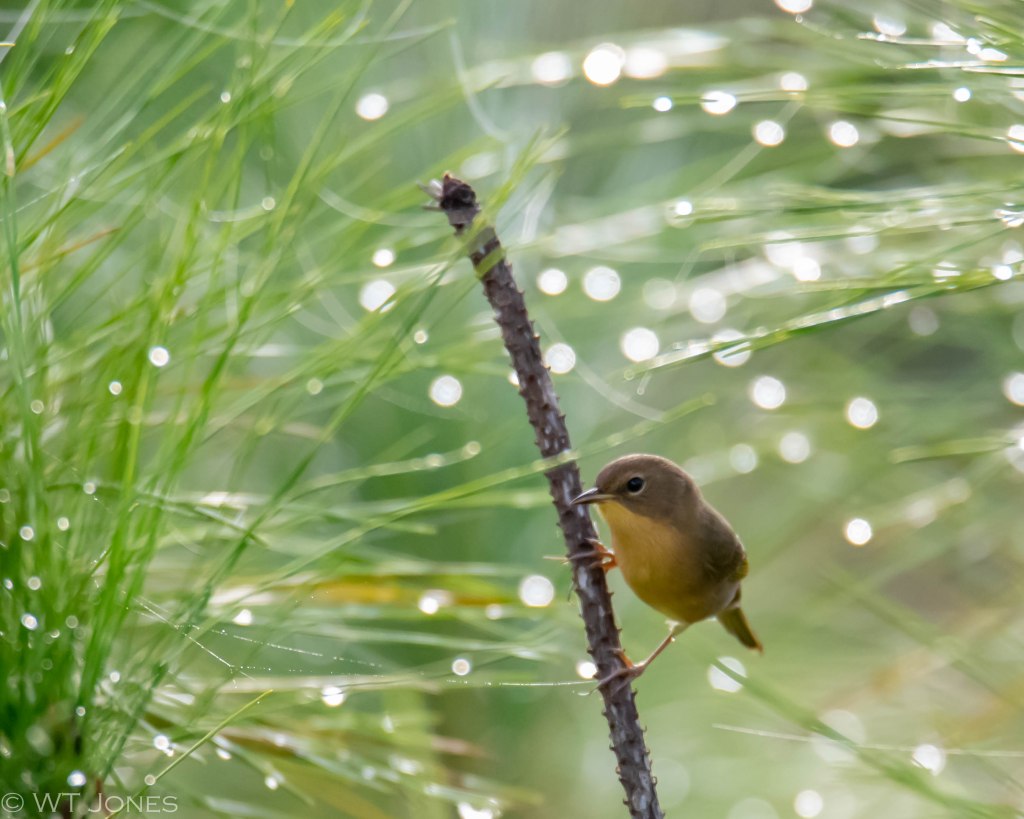
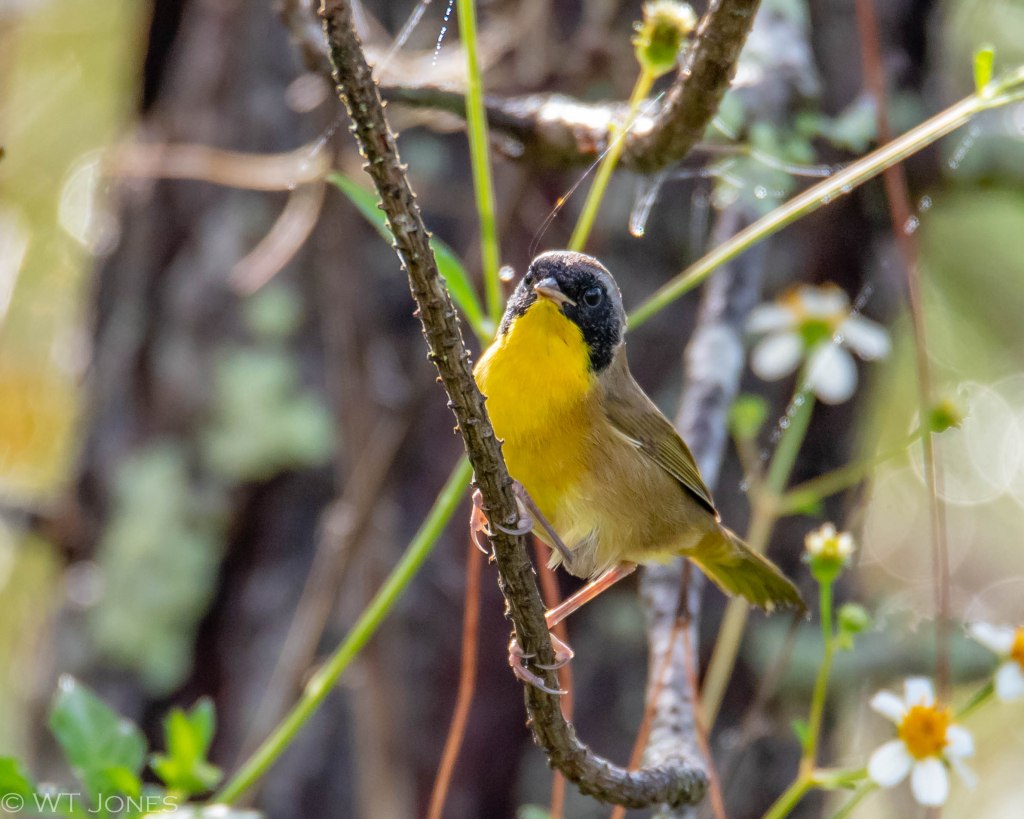
Cocking his head to get a better look at a branch, a male Downy Woodpecker has a red spot on his nape which the female lacks.
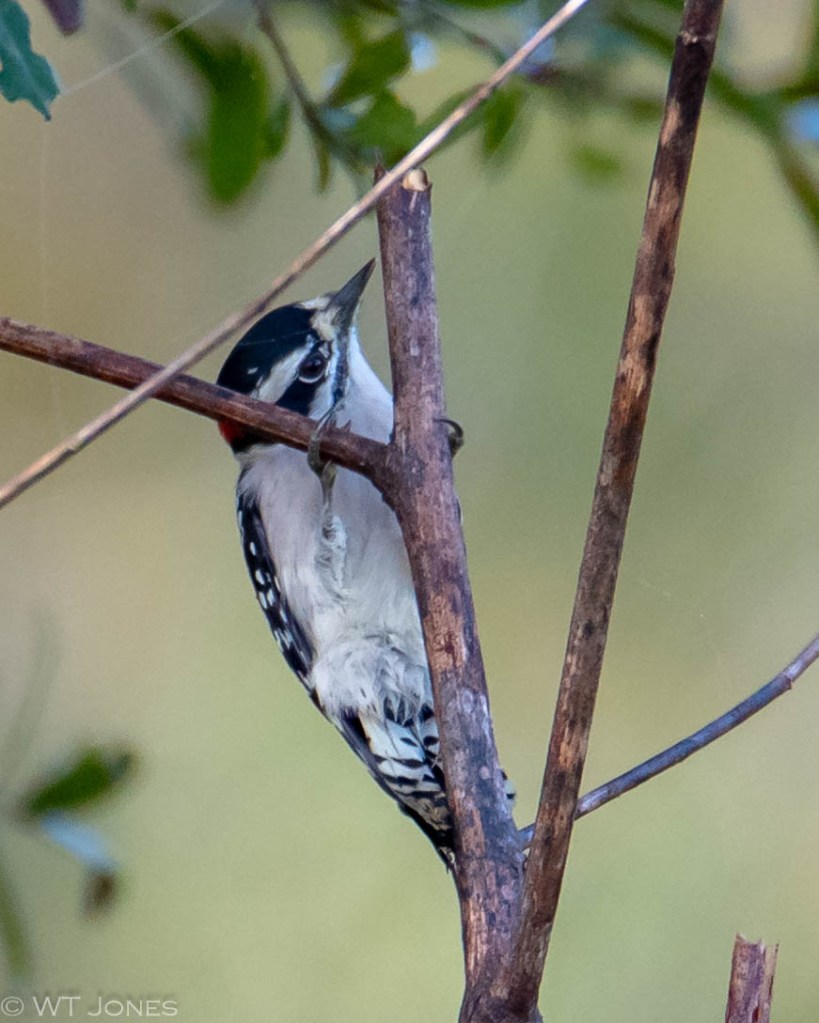
Carpenter-mimic Leafcutter Bee (Megachile xylocopoides). That’s a mouthful. Similar in appearance to Carpenter Bees, the Leafcutter Bees carry pollen on their abdomen instead of leg pouches.
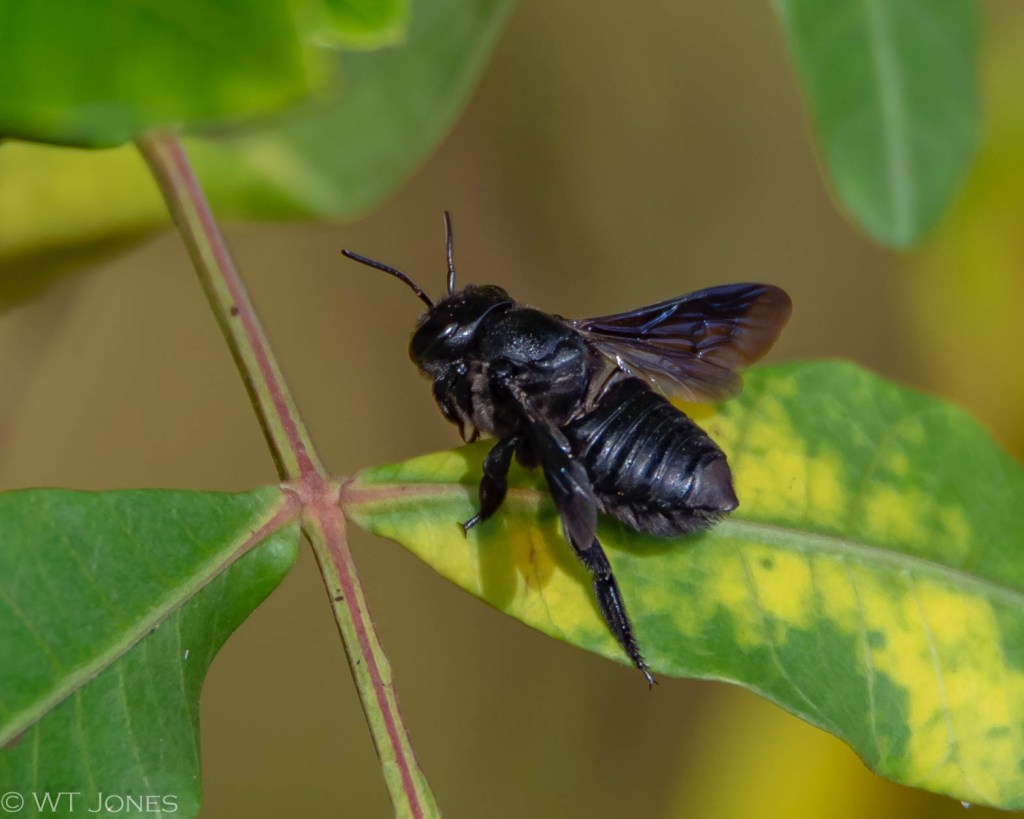
A trio of Red-eyed Vireos were busily feeding along the path. One glanced our way for a moment, decided we were no threat and continued the hunt for juicy caterpillars.
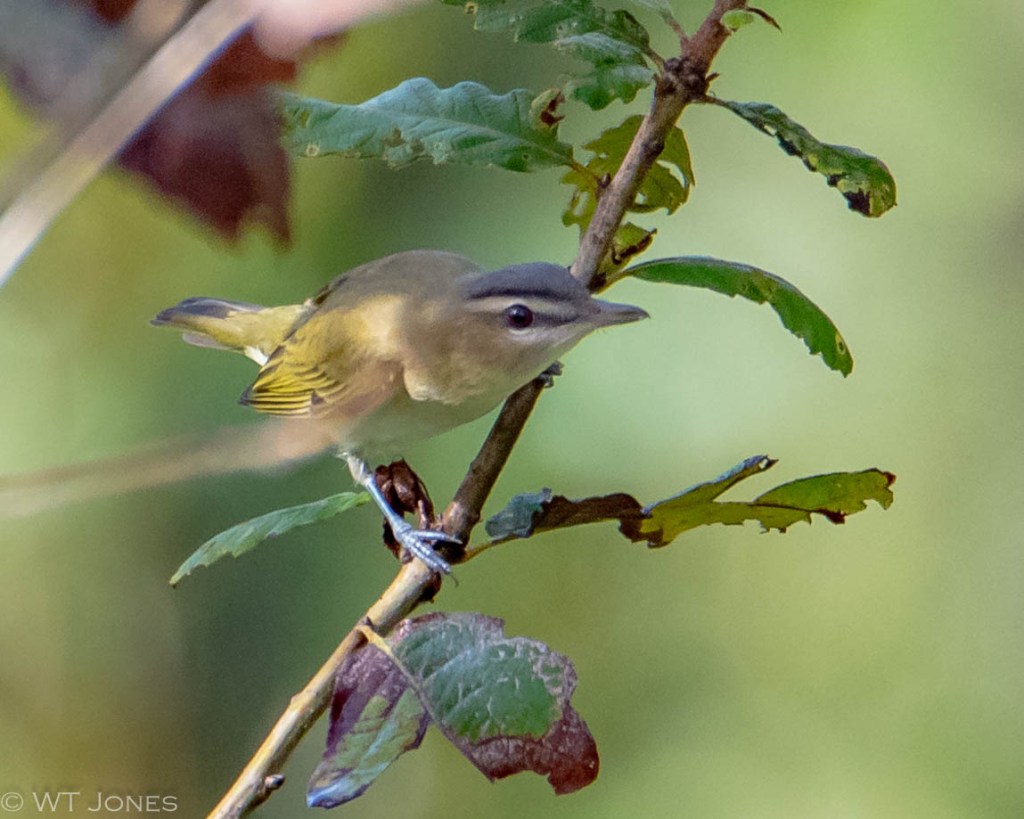
Late molting is likely responsible for the disheveled appearance of this male Northern Cardinal. It is not unusual for cardinals to have two or even three broods in our sub-tropical climate.
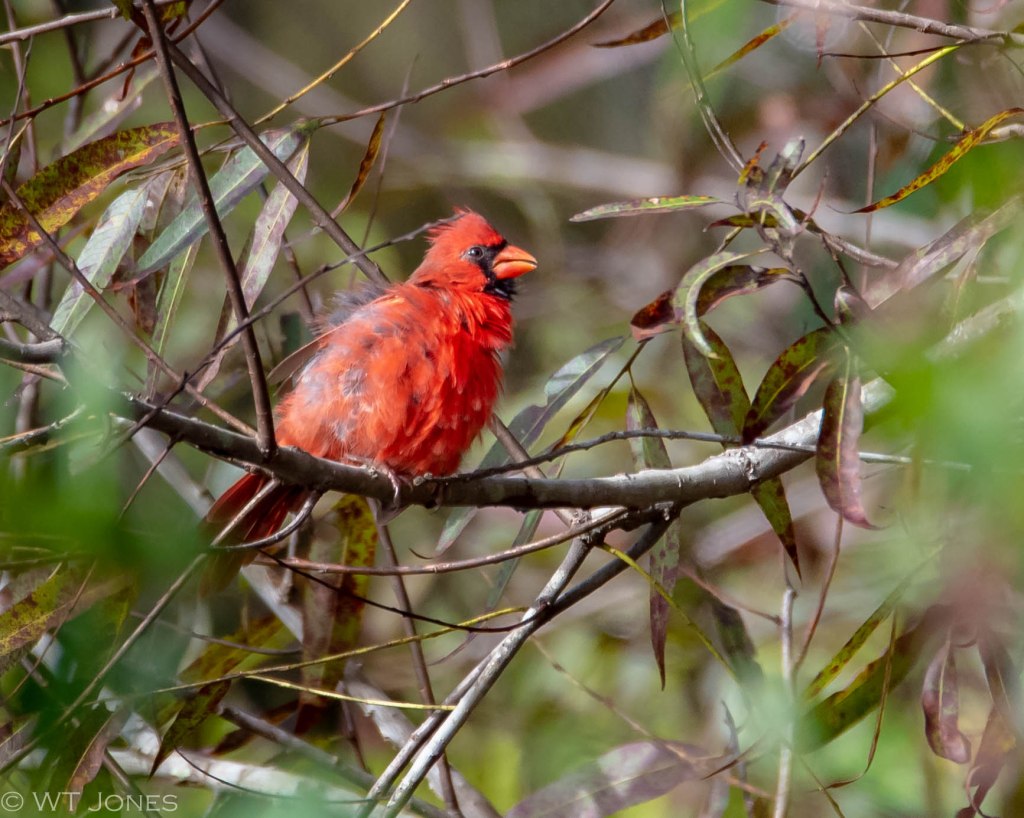
The edge of a large open field normally has a few spots where water collects. Dragonflies love the habitat, and, therefore, so do we! We found over a dozen Band-winged Dragonlets (Erythrodiplax umbrata) in the area.
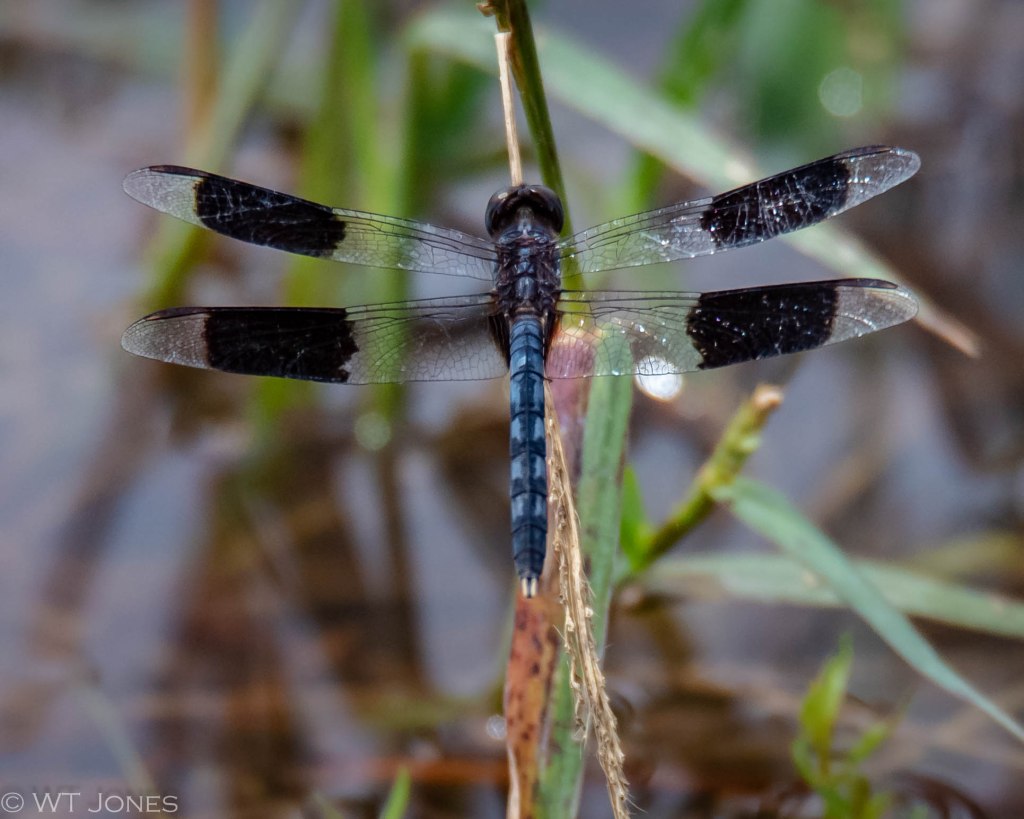
Flashes of red directed our attention to the Scarlet Skimmer (Crocothemis servilia). Not native to North America, this species likely arrived via landscaping plants.
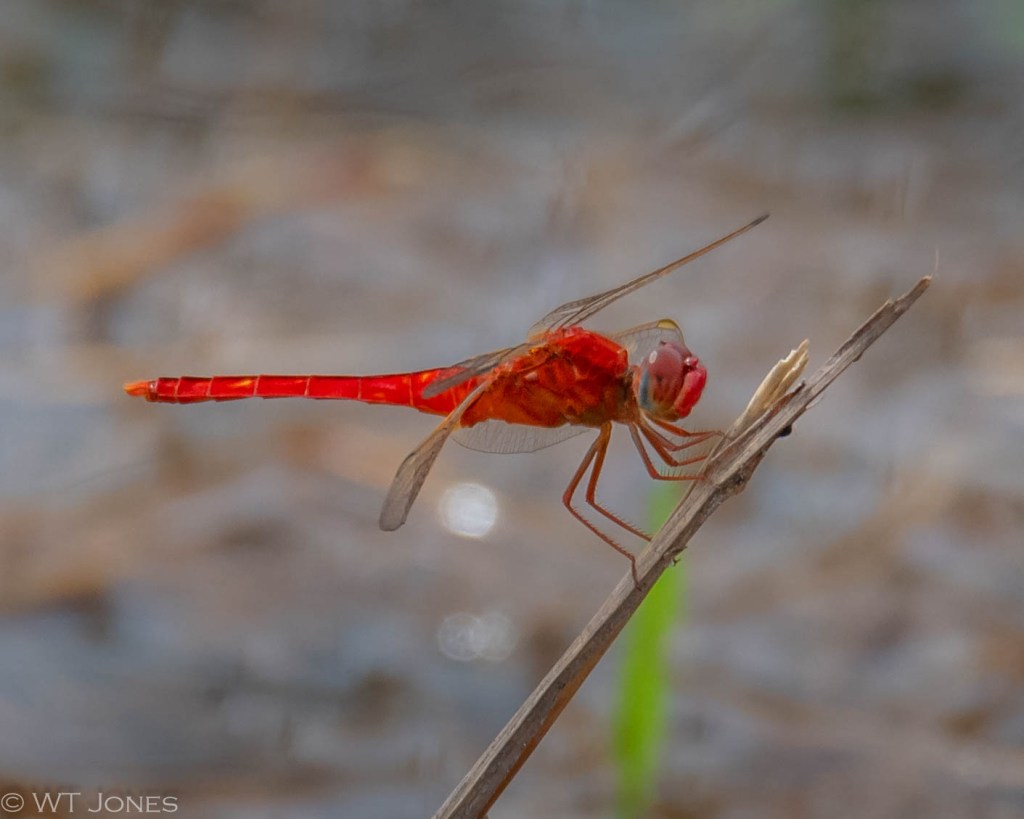
One of the smallest doves in the United States, the Common Ground Dove is about the size of a Song Sparrow.
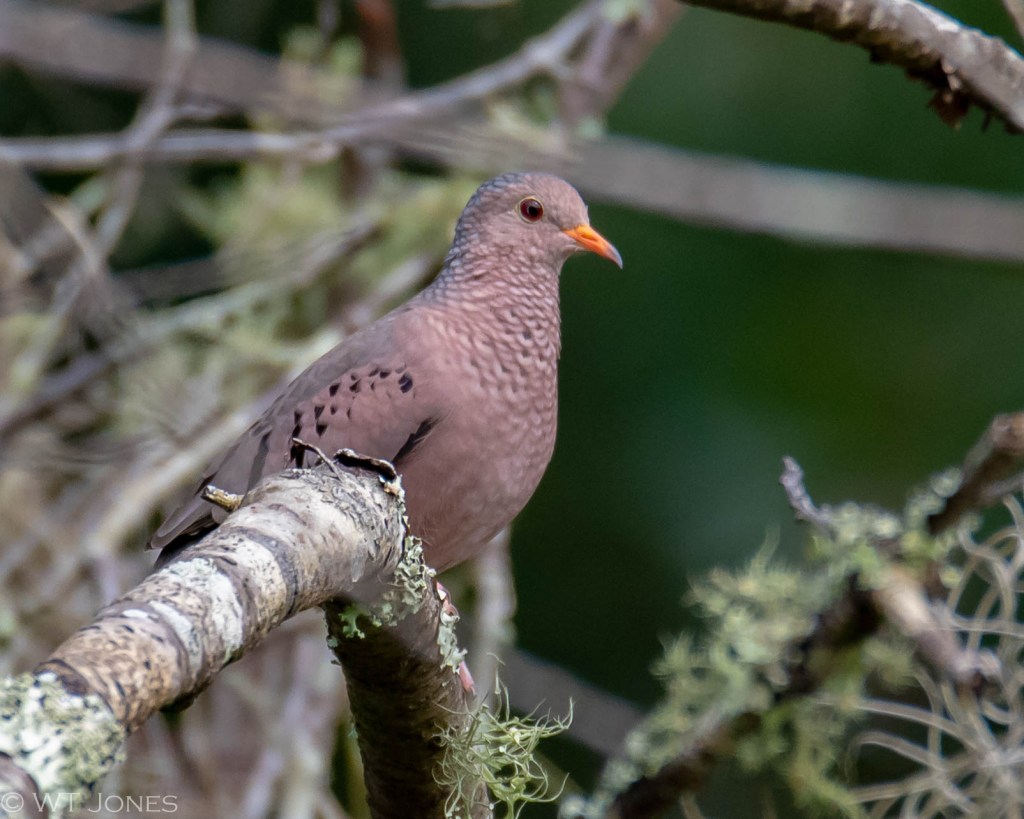
Gangster. The Tufted Titmouse is the first to yell in the forest when a human shows up. He then leads is pack of bird-thugs to challenge our incursion of their territory. Okay, it’s pretty hard to call anything this cute a “gangster”.
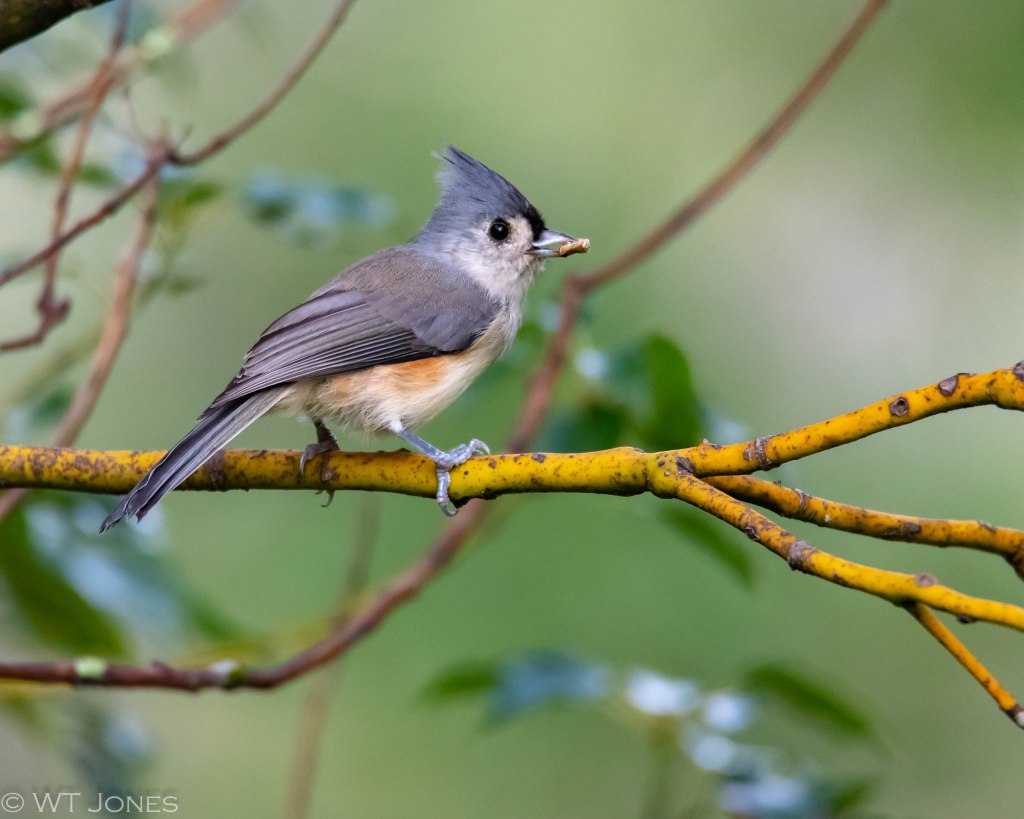
Roseate Skimmers (Orthemis ferruginea) are some of the largest of the skimmers. This female posed for a few seconds and I appreciate it.
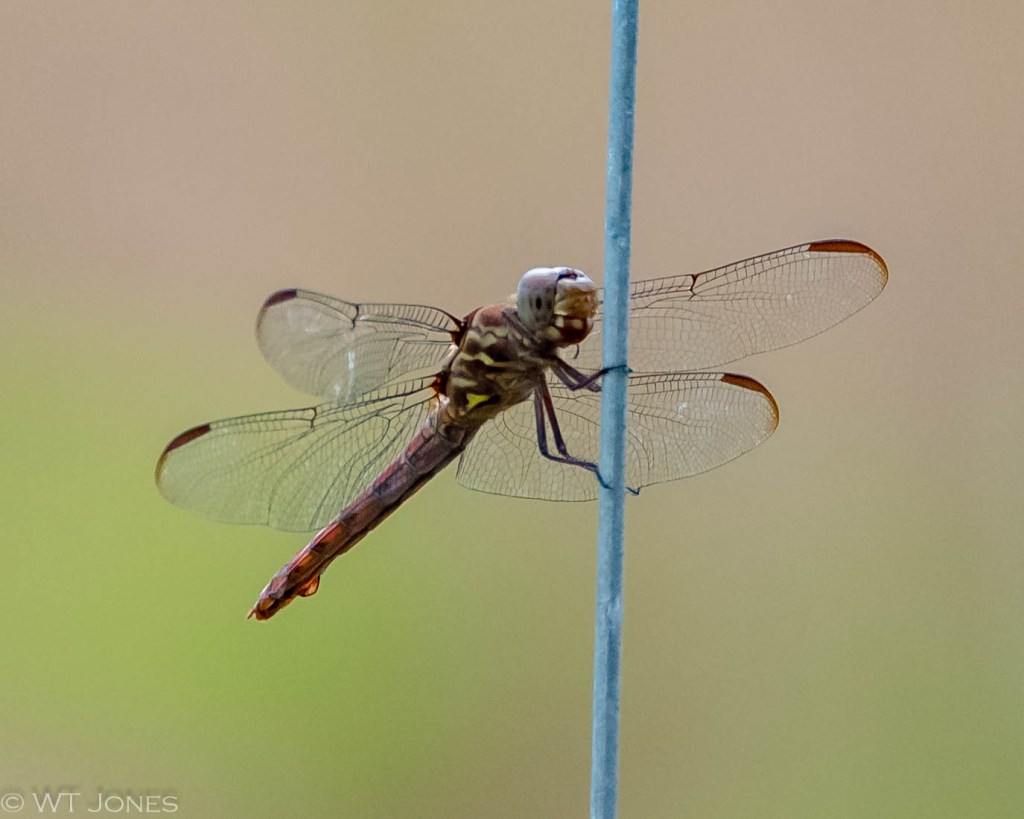
For me, one of the most attractive butterflies we have in the area is the Zebra Swallowtail (Protographium marcellus). As frequently happens, this one lost a bit of its tail, probably due to a close call with a predator.
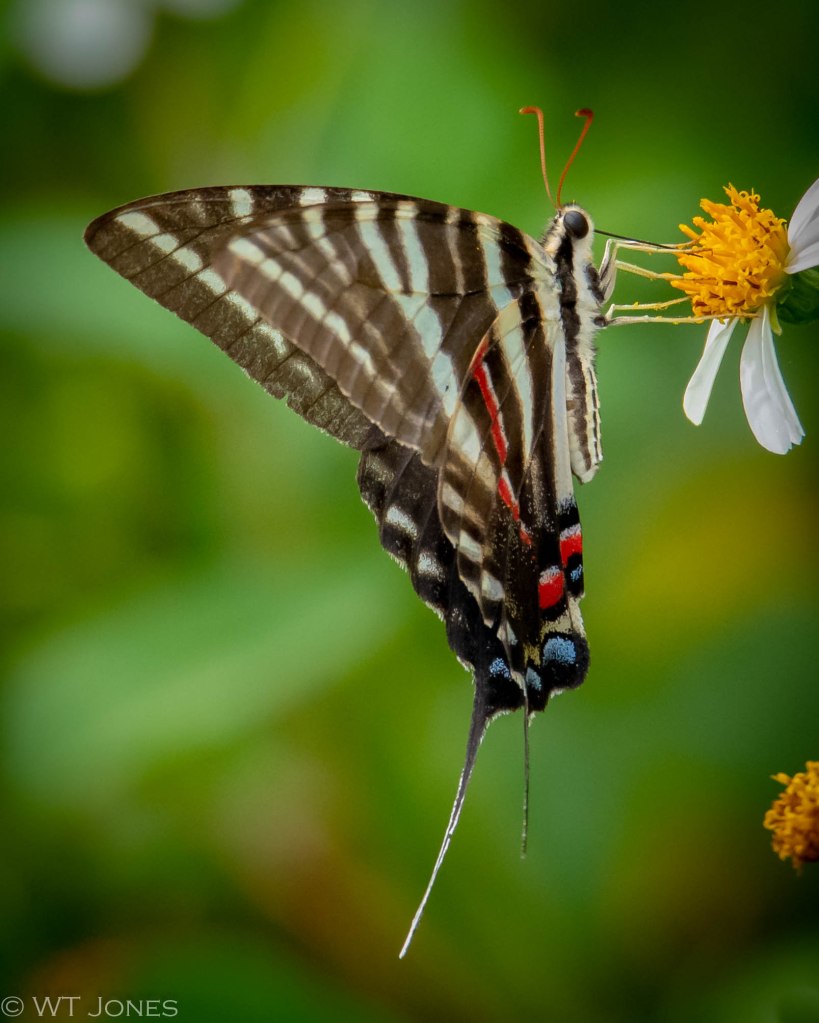
We know fall migration is definitely underway when we hear the rattles of active Belted Kingfishers around our lakes. This guy wouldn’t quit yelling at the water below. We couldn’t see the object of his ire, perhaps Al The Gator?
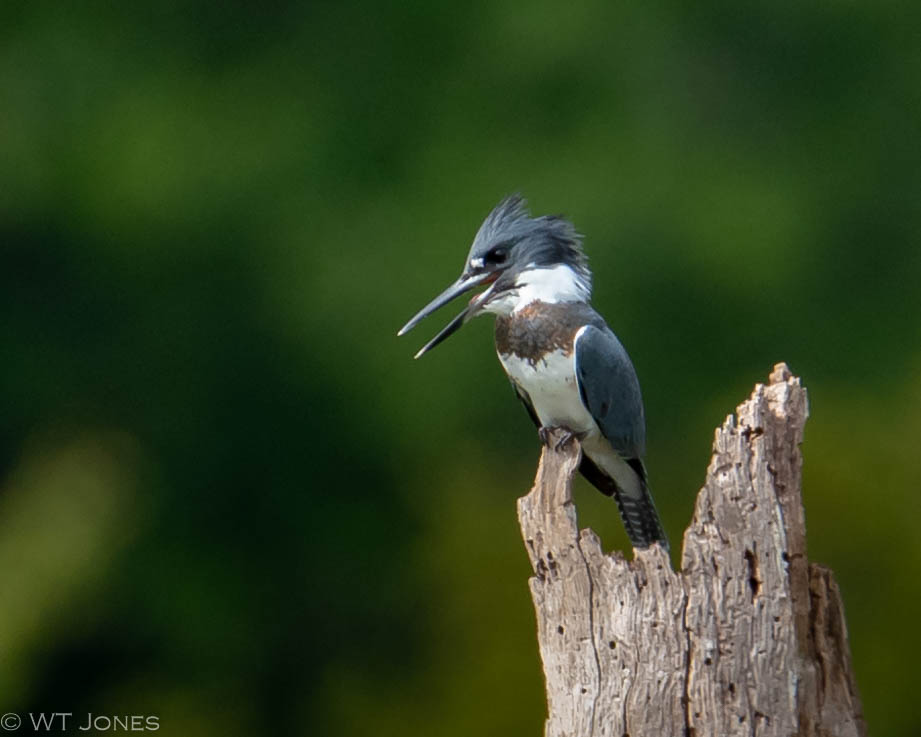
Two dragons we don’t often catch sitting still!
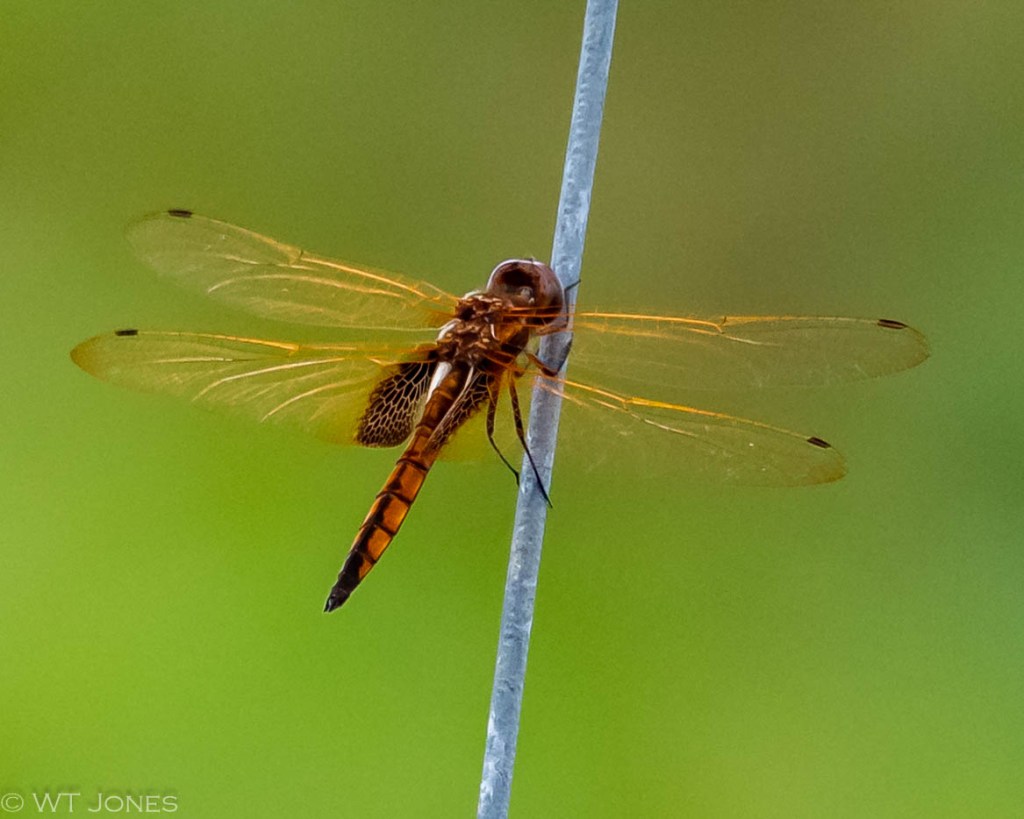
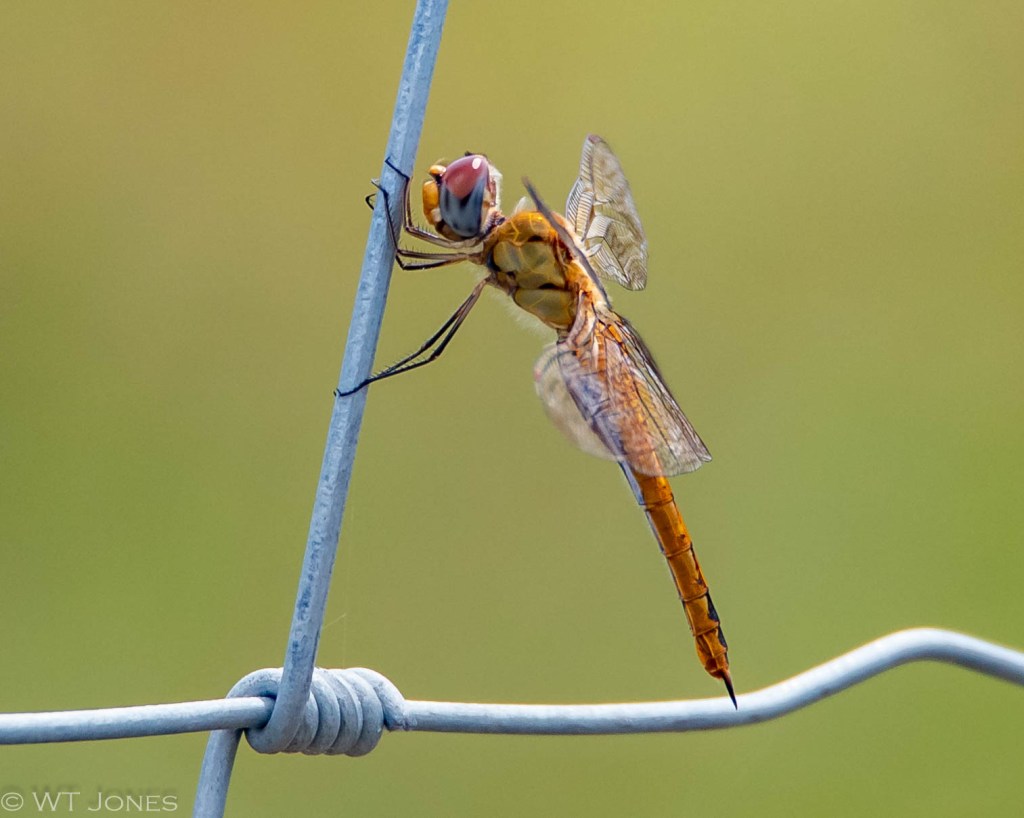
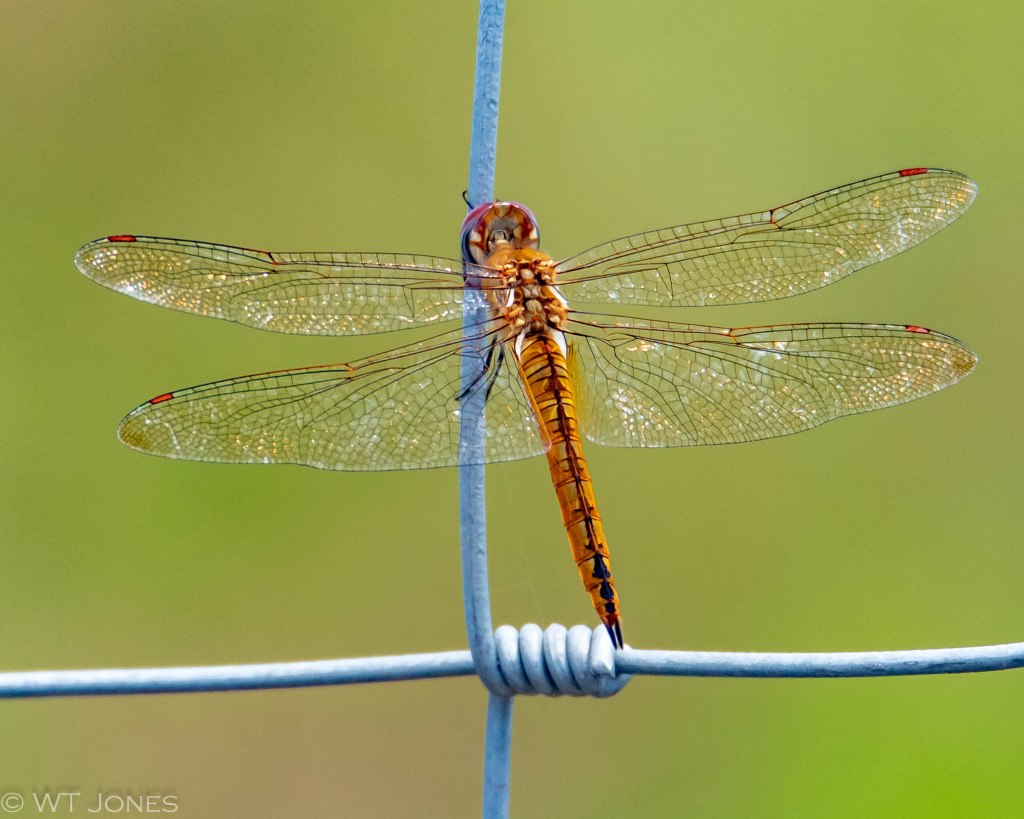
Always curious, constantly singing, beautiful to look upon. Yep, we like White-eyed Vireos!
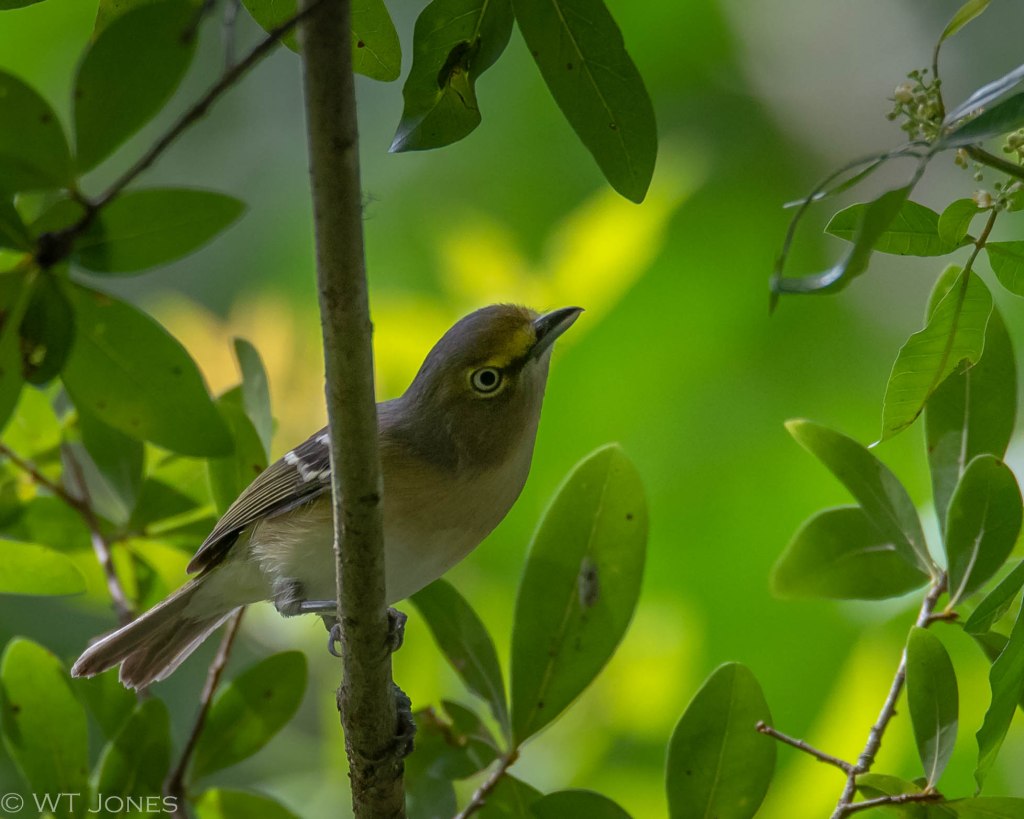
We were a bit surprised to find a few early Palm Warblers. Like, nearly 50 of them! They were staging from a row of large oak trees as they foraged in an open field. It was like welcoming old friends back for an annual reunion. And all of them with tails pumping.
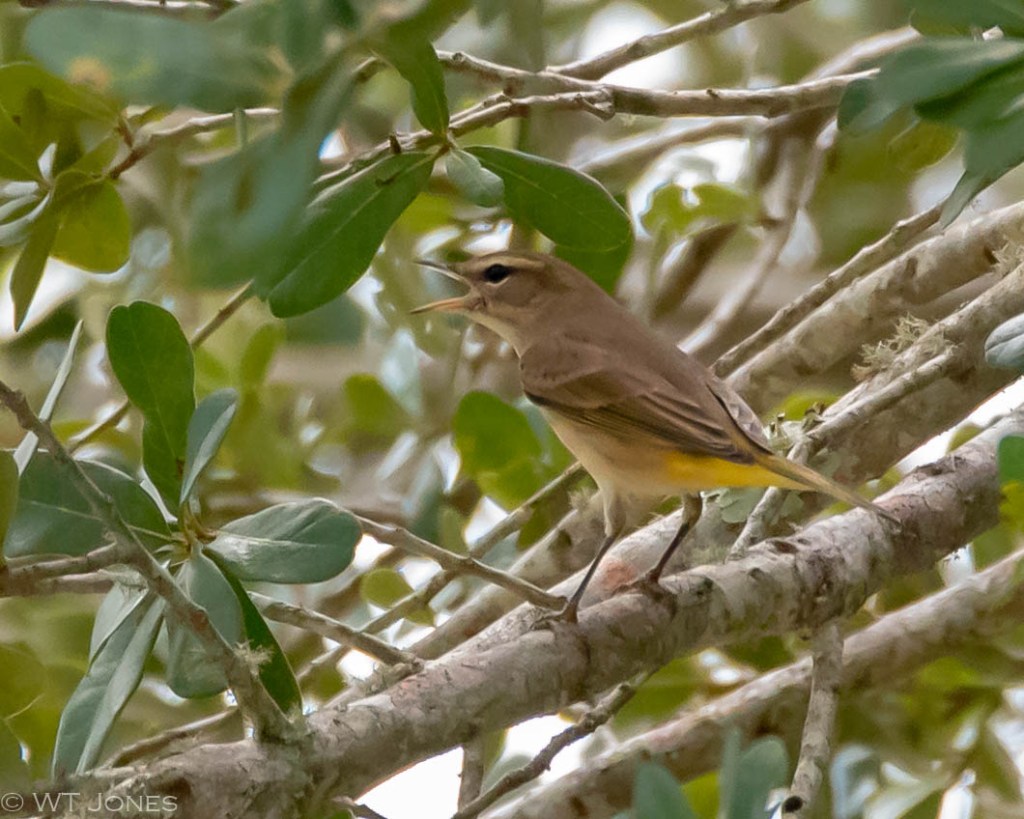
Rounding out our morning outing, that darned car once again proved to be a critter magnet. This time, a Regal Jumping Spider (Phidippus regius) had taken possession of the vehicle. Any move in its direction was immediately challenged, front legs waving. Good thing they are less than an inch long, else we might have felt threatened.
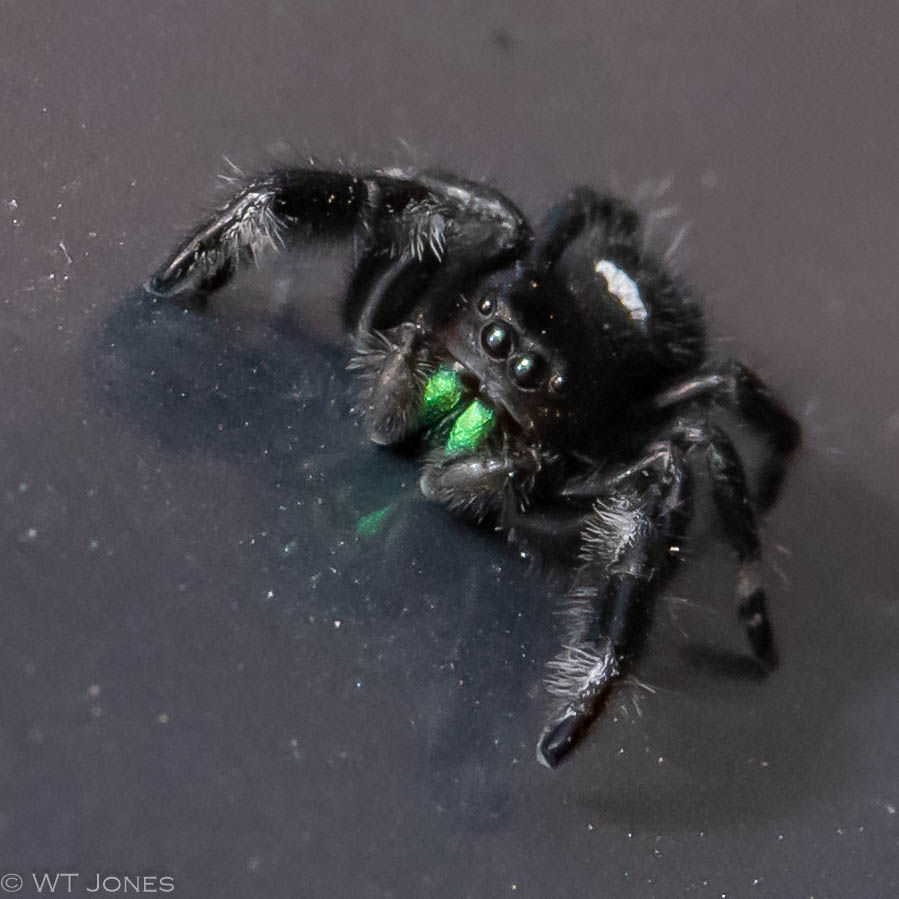
A happy combination of loving each other and enjoying the natural world has resulted in a long-lasting relationship which endures and continues to flourish. Luckiest – man – in – the -world.
We leave you with a definition (and a poem) from “The Devil’s Dictionary” by Ambrose Bierce, one of my all-time favorite writers.
OUT-OF-DOORS, n. That part of one’s environment upon which no government has been able to collect taxes.* Chiefly useful to inspire poets.
I climbed to the top of a mountain one day
To see the sun setting in glory,
And I thought, as I looked at his vanishing ray,
Of a perfectly splendid story.
‘Twas about an old man and the ass he bestrode
Till the strength of the beast was o’ertested;
Then the man would carry him miles on the road
Till Neddy was pretty well rested.
The moon rising solemnly over the crest
Of the hills to the east of my station
Displayed her broad disk to the darkening west
Like a visible new creation.
And I thought of a joke (and I laughed till I cried)
Of an idle young woman who tarried
About a church-door for a look at the bride,
Although ’twas herself that was married.
To poets all Nature is pregnant with grand
Ideas—with thought and emotion.
I pity the dunces who don’t understand
The speech of earth, heaven and ocean.
—Stromboli Smith **
*(This was written in the late 19th century, prior to governments coming up with the revenue-generating idea of “parks”.)
** (Stromboli Smith is one of several dozen aliases used by Bierce throughout his career.)
Enjoy your search for a natural place and come back for a visit!
Additional Information
Well I can tell you right now, there sure in NO discomfort when I find you have made another wonderful post, You are indeed a very fortunate man to have found a wonderful girl to love and be loved in return and t be able to enjoy the wonders of nature in the ways both of you do. You compliment each other in many ways and of course your photographs is second to one Wally. You are also fortunate that both of you are early birds as often you get those 2 opposites in a relationship. I alwys love the way you have with words and it ALWAYS brightens up my day. Have a great week ahead out in the beauty of nature. Regards to Gini.
LikeLike
Dear Margaret, what a kind person you are!
Your absolutely lovely remarks have made us both blush this morning! We hope your day is as beautiful as ours is. Cooler temperatures (which would be “mild” for you) and clear blue skies.
Life is good.
LikeLike
All beautiful shots but the details on the fly are amazing!
LikeLike
Thank you, Dina!
Now, if I could just find a bird that close which would hold still that long!
LikeLike
‘Stromboli Smith’ made me laugh as much as the sight of that cardinal. I confess to being entranced by jumping spiders, and yours is adorable. One of these days I’m going to manage to get a decent photo of one. Maybe I can catch him winking at me!
I heard sandhill cranes on Saturday, down at the San Bernard Refuge. I never spotted them, but I’m sure they came in on last week’s strong norther. From the sound, there could easily have been a couple of dozen of them. The kingfishers are back, too, and the coots are rolling in. I have no idea what I saw today, but there were two of them: I noticed black and white. They were sleek and fast, strong flyers. I’m almost inclined to think they could have been American Avocets, but I’ve only seen a couple of those, so I sure could be wrong. More research is required!
LikeLike
It’s so fascinating to view the passage of the seasons through the prism of migration.
Your sleek and fast black and white birds might have been Black-necked Stilts. When we visited San Bernard a couple of years ago in November there were a good number of them.
Found a field near the house last week where Gini spotted a few dozen cranes. Soon, there will be a couple hundred there.
LikeLiked by 1 person
They definitely weren’t Black-necked Stilts. They’re quite common here, and one of the birds I can recognize in flight, by their calls, and so on. I even managed to capture a pair engaged in their mating ritual, but I’m saving that series of photos for Valentine’s Day!
I forgot to mention that I’m now the proud possessor of a box of Zeiss lens wipes, and they did just fine for cleaning up both the camera body and the lenses. Last weekend, I was back in the same spot, and discovered they do perfectly for that first little sting and itch that suggests poison oak or ivy. I managed to get home with only two little blisters on one knuckle, which was a great improvement over what I dragged home two weeks earlier. Never mind developing an ‘eye’ for hidden birds. I need to develop an eye for those three-leaved monster plants.
LikeLike
You will simply have to return to solve the mystery of the birds!
Very happy to hear those wipes worked on the sticky camera as well as the plant reactions.
LikeLike
Ha! Was I ever wrong! I neglected to mention that I saw the birds in a marina where I’ve been working, and they wheeled in again today to visit the swimming pool. This time, a pair hung around, after chasing away some others of their kind. They roamed the palm thatch on the palapas, presumably checking for insects, and then took a stroll along the dock, where I managed to take a photo of them with my phone. And they were (ta-da!) Egyptian geese! I guess the white underwings in flight made me think they were black and white birds. Apparently they’ve been spreading around golf courses and such in Austin and San Antonio.
LikeLiked by 1 person
Aha! Another Egyptian mystery solved.
LikeLiked by 1 person
Your posts are always a delight, both in words and photos, Wally! Never too many, and I always marvel at your skill of beautiful captures. You are an inspiration to us all!
LikeLike
You are too kind, Donna.
But I sure appreciate it!
LikeLiked by 1 person
Hey. That’s not fair. You have meteorologists? We have weather presenters. Mostly their qualification seems to be that they are photogenic and are able to tell porkies while keeping a straight face.
You and Gini starting the day with a pair of Red-shouldered Hawks followed by a Floridian alfresco breakfast sounds pretty good to me. Marginally better than standing around in the cold and rain along Pilling shore while cupping a rapidly cooling cup of Thermos coffee.
You seem to be enjoying peak migration and masses of warblers Wally? Ours is pretty much over and the season moving inexorably into winter. We changed the clocks Saturday to daylight saving so at 5pm it’s dusk and soon 4pm and hardly worth getting out of bed in the morning. The Cardinal made me laugh – looks like he had a hectic weekend and got dragged through a hedge backwards, apparently a little like me according to she who knows these things.
The vireo – should be renamed – Wide Eyed Vireo!
And after you drew attention to the possibilities of a new tax I have emailed Sunak and Johnson of our Conservative (ha,ha) Government to suggest an addition to their next socialist Budget.
LikeLike
A meteorologist by any other name would forecast sun as sleet.
We are definitely spoiled with our outdoor dining habits. A perk of senior citizenry. (Of course, we’ve been practicing for the moment for a very long time.)
Our peak fall migration is still in progress. Most of the warbler waves will be clearing out, some of which like it here and will remain all winter and waterfowl are now starting to trickle in.
Good luck with communicating with your erstwhile governmental leadership.
(I looked up “Conservative Government” and found it defined as “oxymoron”. Who knew?)
LikeLike
No such thing as too many photos when you are the photographer, Wally! Every one of the shots in this post is a beauty, and I could only wish for more. An entertaining and interesting post, topped off with a fun poem – thank you!
All is good here – had our first frost of this autumn last night.
Best wishes to you both – – – Richard
LikeLike
Thank you, Richard!
Frost? What is that?
🙂
All the best from us to you and Lindsay.
LikeLike
Wally – You won’t ever catch me complaining about too many photos. All of yours are wonderful to look at!
But I also enjoy your writing. And I appreciated the poem you quoted today – I’d never seen that one.
Thanks!
LikeLike
Happy November, Ed!
Thank you for the kind words. Bierce was an interesting character, to say the least.
Fall birds are arriving in force!
LikeLike
Another great post, filled with beautiful birds and photos. Take care, enjoy your day!
LikeLike
Good Morning, Eileen!
Thank you so much. We appreciate your visit and hope your Maryland Autumn is wonderful!
LikeLiked by 1 person
Ooh and ahhh.
Not too many photos at all.
Thank you.
LikeLike
Thank you very much, EC!
Gini and I hope your Spring is going well and that you are able to get out and enjoy it a bit.
LikeLike
And there is my packet of Florida sunshine! Many thanks Wally.
Fantastic warblers and spectacular dragons.
LikeLike
You’re very welcome, Brian. We had to filter out a bit of fog before sending, as we figured you have plenty of that on hand.
‘Twas a good day.
LikeLiked by 1 person
Oh my goodness, I chuckled and grinned and awwwed and hmmmed… your post was utterly delightful. I have no problem at all with LOTS of pictures… you and Gini (and Ambrose Bierce!) are welcome in my browser anytime!
LikeLike
Thanks very much, Sam!
We have fun and hope everyone else does, too.
LikeLike
By your definition, Wally, I suspect that there are many “luckiest men in the world.”
LikeLike
Absolutely, David. Thank goodness.
LikeLike